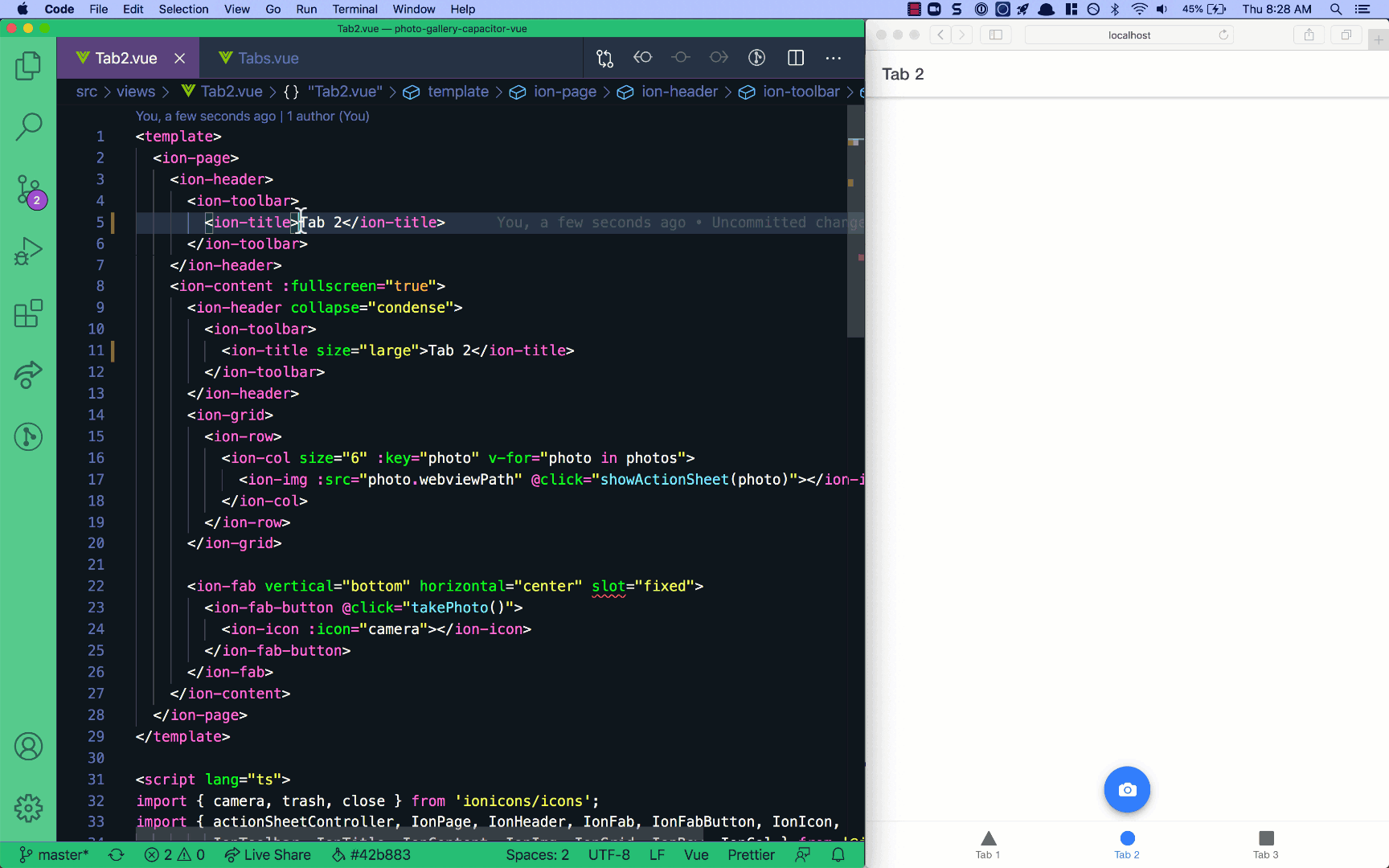Your First Ionic App: Vue
The great thing about Ionic is that with one codebase, you can build for any platform using just HTML, CSS, and JavaScript. Follow along as we learn the fundamentals of Ionic app development by creating a realistic app step by step.
Here’s the finished app running on all 3 platforms:
What We'll Build
We'll create a Photo Gallery app that offers the ability to take photos with your device's camera, display them in a grid, and store them permanently on the device.
Highlights include:
- One Vue-based codebase that runs on the web, iOS, and Android using Ionic Framework UI components.
- Deployed as a native iOS and Android mobile app using Capacitor, Ionic's official native app runtime.
- Photo Gallery functionality powered by the Capacitor Camera, Filesystem, and Preferences APIs.
Find the complete app code referenced in this guide on GitHub.
Download Required Tools
Download and install these right away to ensure an optimal Ionic development experience:
- Node.js for interacting with the Ionic ecosystem. Download the LTS version here.
- A code editor for... writing code! We are fans of Visual Studio Code.
- Command-line interface/terminal (CLI):
- Windows users: for the best Ionic experience, we recommend the built-in command line (cmd) or the Powershell CLI, running in Administrator mode.
- Mac/Linux users, virtually any terminal will work.
Install Ionic Tooling
Run the following in the command line terminal to install the Ionic CLI (ionic), native-run, used to run native binaries on devices and simulators/emulators, and cordova-res, used to generate native app icons and splash screens:
To open a terminal in Visual Studio Code, go to Terminal -> New Terminal.
npm install -g @ionic/cli@latest native-run
The -g option means install globally. When packages are installed globally, EACCES permission errors can occur.
Consider setting up npm to operate globally without elevated permissions. See Resolving Permission Errors for more information.
Create an App
Next, create an Ionic Vue app that uses the "Tabs" starter template and adds Capacitor for native functionality:
ionic start photo-gallery tabs --type vue
This starter project comes complete with three pre-built pages and best practices for Ionic development. With common building blocks already in place, we can add more features easily!
Next, change into the app folder:
cd photo-gallery
Next we'll need to install the necessary Capacitor plugins to make the app's native functionality work:
npm install @capacitor/camera @capacitor/preferences @capacitor/filesystem
PWA Elements
Some Capacitor plugins, including the Camera API, provide the web-based functionality and UI via the Ionic PWA Elements library.
It's a separate dependency, so install it next:
npm install @ionic/pwa-elements
After installation, open up the project in your code editor of choice.
Next, import @ionic/pwa-elements by editing src/main.ts.
// Above the createApp() line
import { defineCustomElements } from '@ionic/pwa-elements/loader';
defineCustomElements(window);
That’s it! Now for the fun part - let’s see the app in action.
Run the App
Run this command in your shell:
ionic serve
And voilà! Your Ionic app is now running in a web browser. Most of your app can be built and tested right in the browser, greatly increasing development and testing speed.
Photo Gallery!!!
There are three tabs. Click on the Tab2 tab. It’s a blank canvas, aka the perfect spot to transform into a Photo Gallery. The Ionic CLI features Live Reload, so when you make changes and save them, the app is updated immediately!

Open /src/views/Tab2.vue. We see:
<template>
<ion-page>
<ion-header>
<ion-toolbar>
<ion-title>Tab 2</ion-title>
</ion-toolbar>
</ion-header>
<ion-content :fullscreen="true">
<ion-header collapse="condense">
<ion-toolbar>
<ion-title size="large">Tab 2</ion-title>
</ion-toolbar>
</ion-header>
<ExploreContainer name="Tab 2 page" />
</ion-content>
</ion-page>
</template>
ion-header represents the top navigation and toolbar, with "Tab 2" as the title. Let’s rename it:
<ion-title>Photo Gallery</ion-title>
We put the visual aspects of our app into <ion-content>. In this case, it’s where we’ll add a button that opens the device’s camera as well as displays the image captured by the camera. But first, remove the ExploreContainer component, beginning with the import statement:
import ExploreContainer from '@/components/ExploreContainer.vue';
Next, remove the ExploreContainer node from the HTML markup in the template.
<ExploreContainer name="Tab 2 page" />
We'll replace it with a floating action button (FAB). First, update the imports within the <script setup> tag to include the Camera icon as well as some of the Ionic components we'll use shortly:
import { camera, trash, close } from 'ionicons/icons';
import {
IonPage,
IonHeader,
IonFab,
IonFabButton,
IonIcon,
IonToolbar,
IonTitle,
IonContent,
IonGrid,
IonRow,
IonCol,
IonImg,
} from '@ionic/vue';
Since our pages are generated as Vue Single File Components using the <script setup> syntax these items are now exposed for use in our template.
Add the FAB to the bottom of the page. Use the camera image as the icon, and call the takePhoto() function when this button is clicked (to be implemented soon):
<ion-content :fullscreen="true">
<ion-fab vertical="bottom" horizontal="center" slot="fixed">
<ion-fab-button @click="takePhoto()">
<ion-icon :icon="camera"></ion-icon>
</ion-fab-button>
</ion-fab>
</ion-content>
We’ll be creating the takePhoto method and the logic to use the Camera and other native features in a moment.
Next, open src/views/TabsPage.vue, remove the ellipse icon from the import and import the images icon instead:
import { images, square, triangle } from 'ionicons/icons';
Within the tab bar (<ion-tab-bar>), change the label to "Photos" and the ellipse icon to images for the middle tab button:
<ion-tab-button tab="tab2" href="/tabs/tab2">
<ion-icon :icon="images" />
<ion-label>Photos</ion-label>
</ion-tab-button>
That’s just the start of all the cool things we can do with Ionic. Up next, implementing camera taking functionality on the web, then building for iOS and Android.